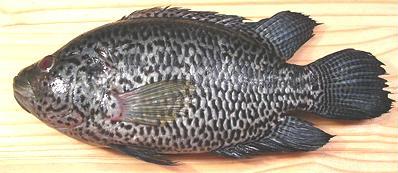 [Unidentified]
[Unidentified]
At first this fish looks a lot like the common Tilapia, but you'll quickly notice it's comparitively thick and rather heavy. This fish was grown in Taiwan and purchased at an Asian market in Los Angeles labeled "Tiger Fish". It was 12 inches long and weighed 1-1/2 pounds.
|
The flesh of this fish is fine grained and tender. It has a slightly gray tint but not to the extent of making in unappetizing. It holds together well enough for most methods of fish cooking. Flavor is pleasant and moderate but distinct, so it's best for people who like fish. Prep & Cleaning: This fish is covered with large stiff scales with moderate adhesion. They scrape off with moderate effort and don't fly around too badly. The body cavity is short so there's not a whole lot in it, but at the top is a large and rather tough swim bladder. You'll need kitchen shears to cut the gills loose and there are substantial grinding stones in the throat. Filleting: This fish has an easy to follow bone structure, excpet for the rib cage. The ribs are short but thick, sharply curved and very difficult to follow. When you get to the ribcage, cut it from the backbone with kitchen shears and deal with it on the fillet. The ribs cannot be pulled with pliers, and the bones go all the way out to the skin, so just cut that part off the fellet and cut the fleshy belly from the bottom of the ribs (it's quite usable). Toss the ribs into the stock pot. Skin: The skin is very tough and easy to remove using the long knife and cutting board method. It has moderate initial shrink when it is heated, but quickly relaxes. The skin does not have an "off" or bitter flavor. . Yield: A 1.5 pound fish yielded 9-3/4 ounces of skin-on fillet (41%). Including the belly pieces it was 10-1/4 ounces (43%). Skin-off it was 8-3/4 ounces with the belly pieces (36%). Cooking: Because the fillets are very thick at the front end, this is not a good candidate for pan frying. It poaches quite well with just enough integrity to so whole fillets can be poached without breaking up. Stock: Heads, bones and fins make a quite serviceable fish stock that has a slightly tart flavor. There is a moderate amount of oil which you should remove using your gravy separator. |
sf_tigerz 100222 - www.clovegarden.com
© Andrew Grygus 2011 - info@clovegarden.com -
Photos on this page not otherwise credited are ©
cg1. Linking to and non-commercial use
of this page permitted.